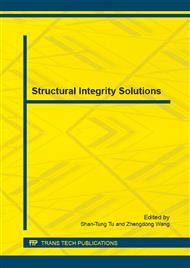[1]
R.H. Dodds, J.C.F. Shih, T.L. Anderson, Continuum and micromechanics treatment of constraint in fracture, Int J Fract. 64 (1993) 101-33.
DOI: 10.1007/bf00016693
Google Scholar
[2]
K.M. Nikbin, D.J. Smith, G.A. Webster, Prediction of creep crack growth from uniaxial creep data. Proce R Soc London. Ser A 396 (1984) 183-197.
DOI: 10.1098/rspa.1984.0116
Google Scholar
[3]
K.M. Nikbin, D.J. Smith, G.A. Webster, An engineering approach to the prediction of creep crack growth, J Eng Mater Tech 108 (1986) 186-191.
DOI: 10.1115/1.3225859
Google Scholar
[4]
K.M. Nikbin, Justification for meso-scale modelling in quantifying constraint during creep crack growth, Mater Sci Eng A. 365 (2004) 107-113.
DOI: 10.1016/j.msea.2003.09.014
Google Scholar
[5]
G.A. Webster, R.A. Ainsworth, High temperature component life assessment. London, Chapman and Hall, (1994).
Google Scholar
[6]
M. Yatomi, N.P. O'Dowd, K.M. Nikbin, G.A. Webster, Theoretical and numerical modelling of creep crack growth in a carbon-manganese steel, Eng Fract Mech. 73 (2006) 1158-1175.
DOI: 10.1016/j.engfracmech.2005.12.012
Google Scholar
[7]
M. Tabuchi, K. Kubo, K. Yagi, Effect of specimen size on creep crack growth rate using ultra-large CT specimens for 1Cr-Mo-V steel, Eng Fract Mech. 40 (1991) 311-321.
DOI: 10.1016/0013-7944(91)90266-4
Google Scholar
[8]
N.H. Kim, C.S. Oh, Y.J. Kim, C.M. Davies, K.M. Nikbin, D.W. Dean, Creep failure simulations of 316H at 550℃: Part II – Effects of specimen geometry and loading mode, Eng. Fract. Mech. 150 (2013) 169-181.
DOI: 10.1016/j.engfracmech.2013.04.001
Google Scholar
[9]
J.P. Tan, S.T. Tu, G.Z. Wang, F.Z. Xuan, Effect and mechanism of out-of-plane constraint on creep crack growth behavior of a Cr-Mo-V steel, Eng. Fract. Mech. 99 (2013) 324-334.
DOI: 10.1016/j.engfracmech.2013.01.017
Google Scholar
[10]
A. Mehmanparast, C.M. Davies, G.A. Webster, K.M. Nikbin, Creep crack growth rate predictions in 316H steel using stress dependent creep ductility, Materil. at High Temp. 31 (2014) 84-94.
DOI: 10.1179/0960340913z.00000000011
Google Scholar
[11]
J.W. Zhang, G.Z. Wang, F.Z. Xuan, S.T. Tu, Effects of stress-regime dependent creep model and ductility on creep crack growth rate, Eng. Fract. Mech. 2014, submitted.
DOI: 10.1016/j.matdes.2014.09.070
Google Scholar
[12]
J.W. Zhang, G.Z. Wang, F.Z. Xuan, S.T. Tu, Effect of stress dependent creep ductility on creep crack growth behavior of steels for wide range of C*, Materil. at High Temp. 2014, submitted.
DOI: 10.1179/1878641314y.0000000027
Google Scholar
[13]
J.P. Tan, G.Z. Wang, F.Z. Xuan, S.T. Tu, Creep crack growth in a Cr-Mo-V type steel: experimental observation and prediction, Acta Metall. Sin. (Engl. Lett. ) 2011, 81-91.
Google Scholar
[14]
M. Yatomi, K.M. Nikbin, N.P. O'Dowd, Creep crack growth prediction using a damage based approach, Int J Pressure Vessels Piping. 80 (2003) 573-583.
DOI: 10.1016/s0308-0161(03)00110-8
Google Scholar
[15]
M. Yatomi, M. Tabuchi, Issues relating to numerical modelling of creep crack growth, Eng. Frac. Mech. 77 (2010) 3043-3052.
DOI: 10.1016/j.engfracmech.2010.04.024
Google Scholar
[16]
C.S. Oh, N.H. Kim, Y.J. Kim, C. Davies, K.M. Nikbin, D. Dean, Creep failure simulations of 316H at 550℃: Part I – A method and validation, Eng Frac Mech 78 (2011) 2966-2977.
DOI: 10.1016/j.engfracmech.2011.08.015
Google Scholar
[17]
Hibbitt, Karlsson & Sorensen. ABAQUS User's Manual, Version 6. 10, (2011).
Google Scholar
[18]
M.W. Spindler, The multiaxial creep ductility of austenitic stainless steels, Fatigue Frac Eng Mater Struc. 27 (2004) 273-81.
DOI: 10.1111/j.1460-2695.2004.00732.x
Google Scholar
[19]
M.J. Manjoine, Creep-rupture behavior of weldments, Weld J. 1982, 50-57.
Google Scholar
[20]
J.R. Rice, D.M. Tracey, On ductile enlargement of voids in traxial stress fields, J. Mech. Phys. Solids. 17 (1969) 201-17.
DOI: 10.1016/0022-5096(69)90033-7
Google Scholar
[21]
A.F. Cocks, M.F. Ashby, Intergranular fracture during power-law creep under multiaxial stresses, Metal. Sci. 36 (1980) 237-49.
DOI: 10.1179/030634580790441187
Google Scholar
[22]
ASTM E 1457. Standard test method for measurement of creep crack growth rates in metals. Annual Book of ASTM Standards 2001, pp, 945-966.
Google Scholar
[23]
J.P. Tan, G.Z. Wang, F.Z. Xuan, S.T. Tu, Z.D. Wang, Effect of the out-of-plane constraint on creep crack growth property of Cr-Mo-V type steel, In: Proceedings of the ASME 2011 Pressure Vessels and Piping Conference. Maryland, USA, 2011. (PVP2011-57300).
DOI: 10.1115/pvp2011-57300
Google Scholar
[24]
J.P. Tan, G.Z. Wang, F.Z. Xuan, S.T. Tu, Experimental investigation of in-plane constraint and out-of-plane constraint effects on creep crack growth, In: Proceedings of the ASME 2012 Pressure Vessels and Piping Conference. Ontario, Canada, 2012. (PVP2012-78478).
DOI: 10.1115/pvp2012-78478
Google Scholar
[25]
J.P. Tan, Creep life assessment of structures containing crack incorporating constraint effect, Doctoral dissertation, East China University of Science and Technology, (2014).
Google Scholar
[26]
R. Hales, The role of cavity growth mechanisms in determining creep-rupture under multiaxial stresses, Fatigue Fract. Eng. Mater. Struct. 17 (1994) 579-591.
DOI: 10.1111/j.1460-2695.1994.tb00257.x
Google Scholar


